Samsung SSD 840 EVO mSATA (120GB, 250GB, 500GB & 1TB) Review
by Kristian Vättö on January 9, 2014 1:35 PM ESTRandom Read/Write Speed
The four corners of SSD performance are as follows: random read, random write, sequential read and sequential write speed. Random accesses are generally small in size, while sequential accesses tend to be larger and thus we have the four Iometer tests we use in all of our reviews.
Our first test writes 4KB in a completely random pattern over an 8GB space of the drive to simulate the sort of random access that you'd see on an OS drive (even this is more stressful than a normal desktop user would see). I perform three concurrent IOs and run the test for 3 minutes. The results reported are in average MB/s over the entire time. We use both standard pseudo randomly generated data for each write as well as fully random data to show you both the maximum and minimum performance offered by SandForce based drives in these tests. The average performance of SF drives will likely be somewhere in between the two values for each drive you see in the graphs. For an understanding of why this matters, read our original SandForce article.
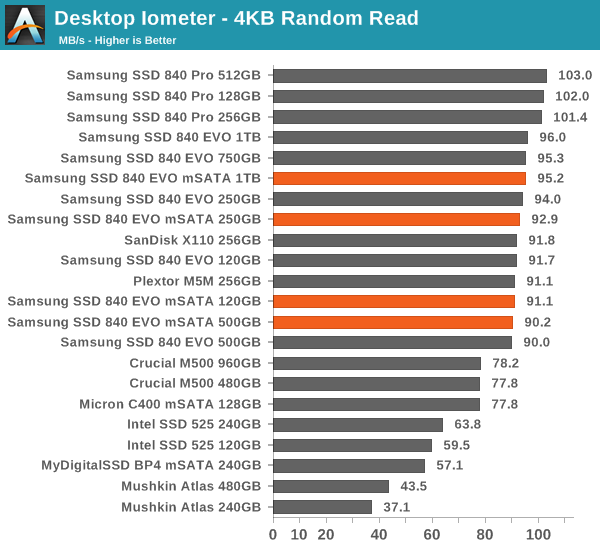
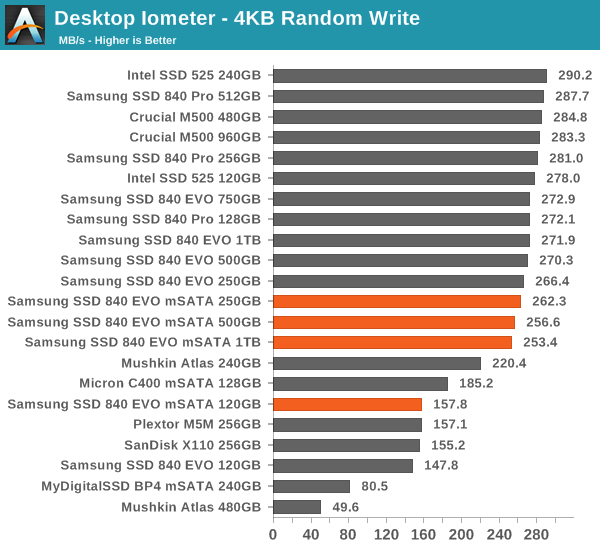
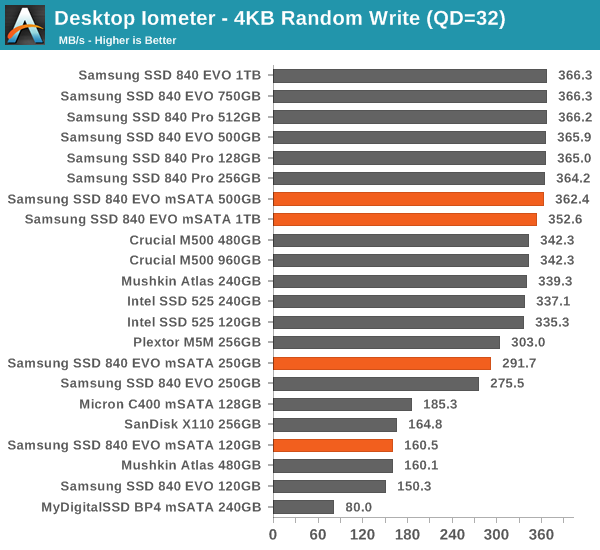
As expected, random IO performance is similar to the original EVO. There is some slight variation of course but nothing that stands out.
Sequential Read/Write Speed
To measure sequential performance I ran a 1 minute long 128KB sequential test over the entire span of the drive at a queue depth of 1. The results reported are in average MB/s over the entire test length.
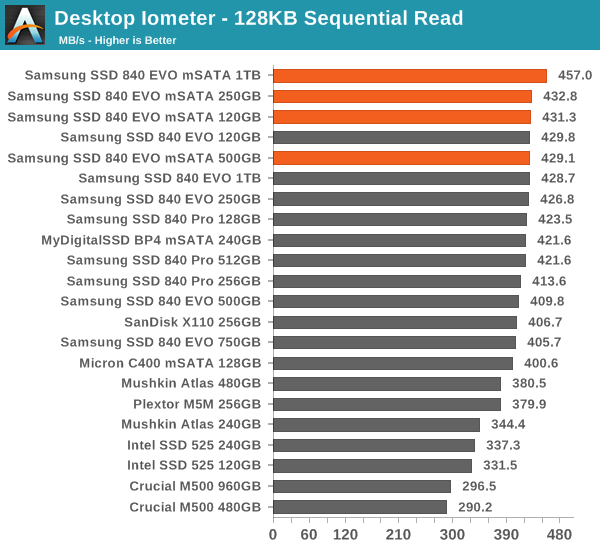
For some reason, the 1TB EVO mSATA is a few percent faster in 128KB sequential read test but falls short in the sequential write test. It's possible that the 16-die NAND has some effect on performance, which would explain the difference, but we're still dealing with rather small differences.
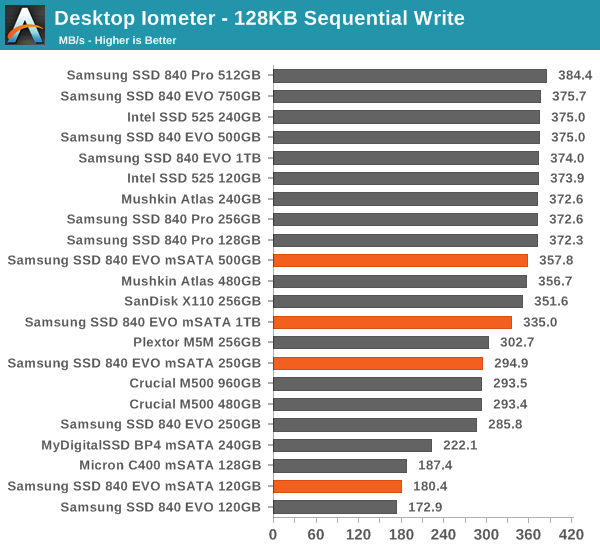
AS-SSD Incompressible Sequential Read/Write Performance
The AS-SSD sequential benchmark uses incompressible data for all of its transfers. The result is a pretty big reduction in sequential write speed on SandForce based controllers.
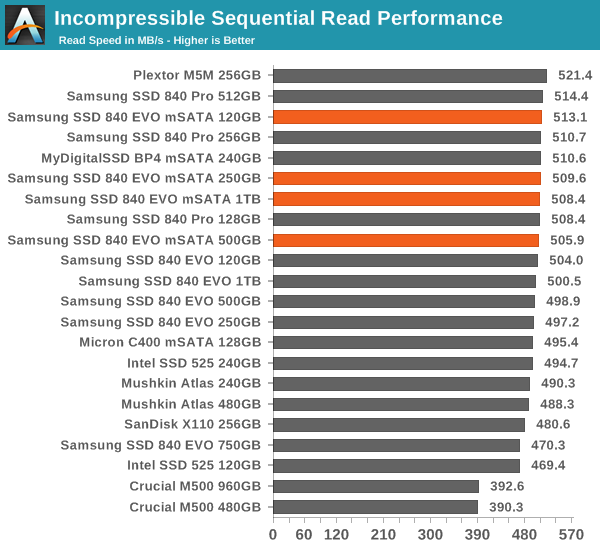
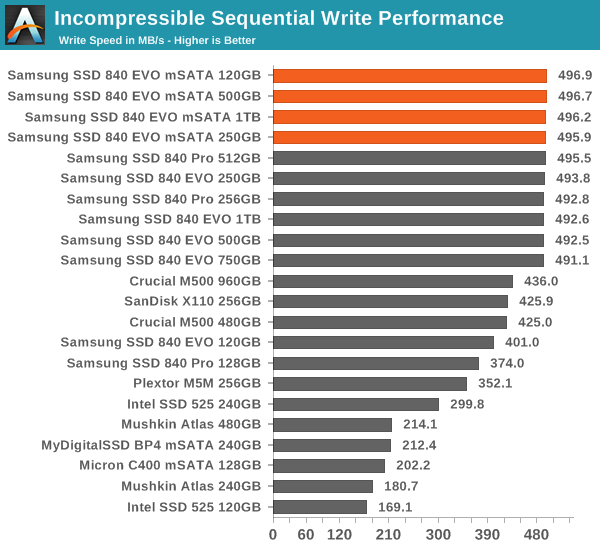










65 Comments
View All Comments
ahar - Thursday, January 9, 2014 - link
Can we also have one for the article? ;)"...so the number's you're seeing here..."
Unit Igor - Saturday, January 11, 2014 - link
Tell me Kristian please would EVO 120GB msata have any advantage over EVO 250gb msata in longer battery life when you compare power consuptipon vs. disk busy times and mb/s.I use my ultrabook only for mails ,somtimes wathing movies and surfing.I dont need more then 120GB SSD but i am willing to buy 250Gb if it would give me more battery life.What i wanted to see in your benchmark is MobileMark 2012 because msata is for laptops and that is where battery life play big roleguidryp - Thursday, January 9, 2014 - link
"endurance is fine for consumer usage"Thanks for your opinion, but I'll stick with MLC.
Do you also think Multi-TB HDDs are fine for consumer use? Since HDDs went over 1TB, they have been failing/wearing out for me regularly. I am sure you can find some theoretical numbers that say these are "fine for consumer usage" as well.
There is a big trend to bigger sizes but lower reliability. That trend can get stuffed.
Samsungs advantage of Being the only TLC player strikes me as a reason to avoid Samsung, so I can avoid TLC and decreasing endurance that goes with it.
Kristian Vättö - Thursday, January 9, 2014 - link
That's just your experience, it's not a proof that over 1TB hard drives are less reliable. We can't go out and start claiming that they are less reliable unless we have some concrete proof of that (failures on our end, statistics etc).The same applies for TLC. All we have is the P/E cycle number and frankly it gives us a pretty good estimation of the drive's lifespan and those numbers suggest that the endurance of TLC is completely fine for consumer usage. Or do you think our calculations are incorrect?
MrSpadge - Thursday, January 9, 2014 - link
And add to that that the P/E cycles are usually conservatively estimated by manufacturers. The SSD-burn-tests at XS sometimes exceed the ratings significantly.guidryp - Thursday, January 9, 2014 - link
I think if you examine any aggregate source of reviews like Newegg you will see a significant drop in drive satisfaction do to early failures, since drives went over 1TB. So it isn't just some personal fluke that half of my >1TB drives have failed worn out, so far.I am really sick of this trend of declining reliability being sold as good enough. If TLC is "good enough" I will take MLC with 3X "good enough" unless the we are talking about 1/3 the price for TLC.
Weren't the Samsung 840s failing in days for Anand last year?
Unlike reviewers, I use my products until they fail, so reliability matters a LOT, and is something that is going in the wrong direction IMO.
Kristian Vättö - Thursday, January 9, 2014 - link
Reliability is not the same as endurance. TLC has lower endurance, that's a fact, but it's not less reliable. Endurance is something you can predict (in the end all electronics have a finite lifespan) but reliability you cannot since there's a lot else than just NAND that can fail. I would claim that today's SSDs are much more reliable than the SSDs we had two years ago -- there haven't been any widespread issues with current drives (compared to e.g. early SandForce drives).Yes, we had a total of three 840 and 840 Pros that failed but that was on pre-production firmware. The retail units shipped with a fixed firmware.
This isn't a new trend. Historically we can go back all the way to 1920s when light bulb companies started rigging their products so the lifespan would be shorter, which would in turn increase sales. Is it fair? Of course not. Do all companies do it? Yes.
I do see your point but I think you're exaggerating. Even TLC SSDs will easily outlive the computer as a whole since the system will become obsolete in in a matter of years anyway if it's not updated.
gandergray - Saturday, January 25, 2014 - link
For information concerning hard drive failure rates that is more objective, please see the following article: http://www.extremetech.com/extreme/175089-who-make... .althaz - Thursday, January 9, 2014 - link
TLC is NOT a trade off in reliability, but a tradeoff in longevity.Longevity is measured in write-cycles and with heavy consumer loads TLC drives will still last for many years.
bsd228 - Thursday, January 9, 2014 - link
Other than the fact that they both store data, SSDs and HDDs have nothing in common, so it's silly to presume a problem that isn't really what you think it is in the first place. HDDs got dirt cheap as we cross the TB threshold and with it went diligent QA. You want 2TB for $80, you're going to get a higher defect rate. And going to 4 or 5 platters just increases the failure points, but the razor thin margins are the culprit here.In contrast, a bigger SSD just means either more chips, or higher density ones. But 16 chips is nothing new, and since there are no mechanical parts, nothing to worry about. Aside from OCZ, the SSD track record for reliability has been pretty solid, and Samsung (and Intel) far better than that. If you want to stick to 256G in your laptop out of a silly fear of TLC, you're just hurting yourself. The Anand guys have already shown how overstated the wear issue has become.